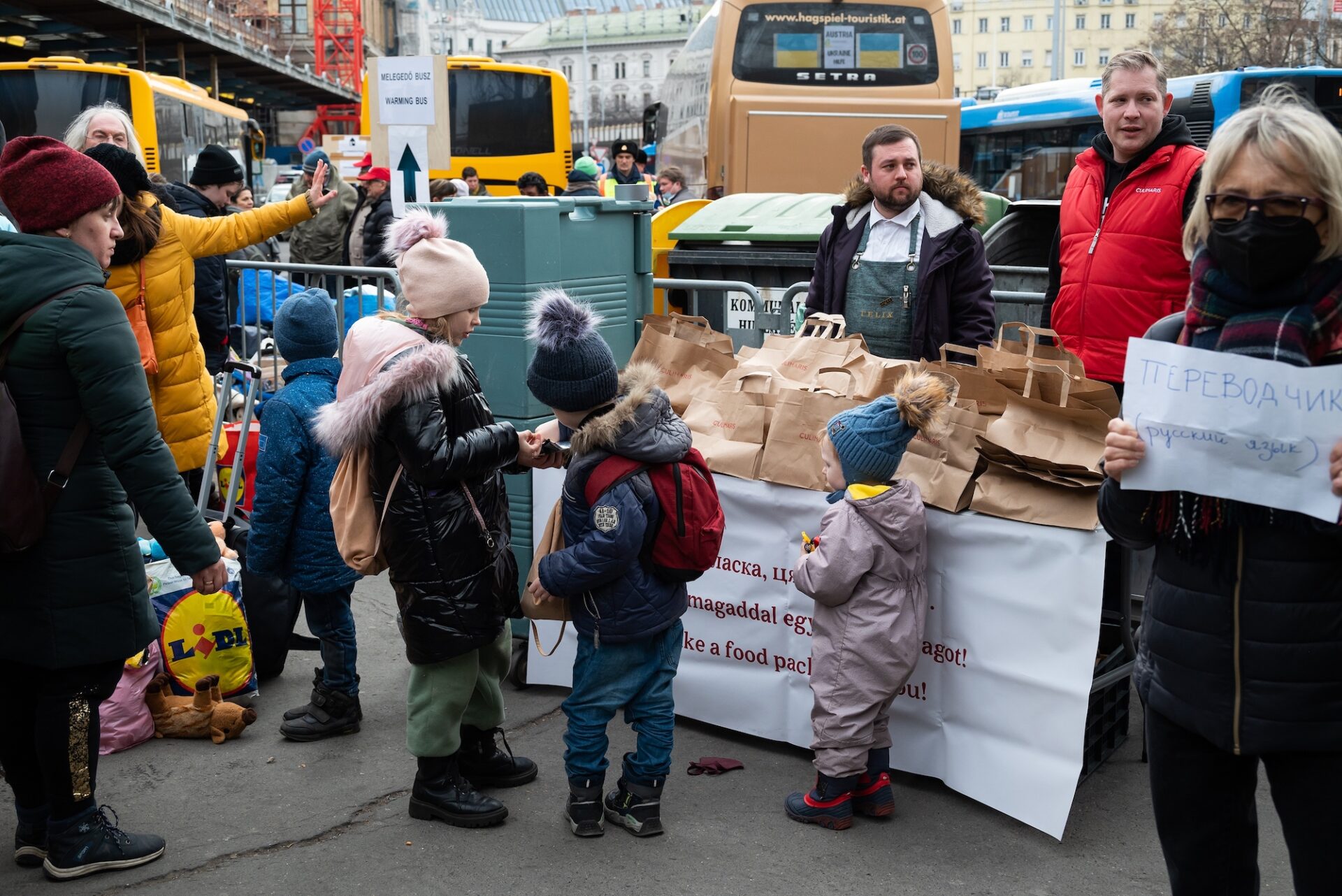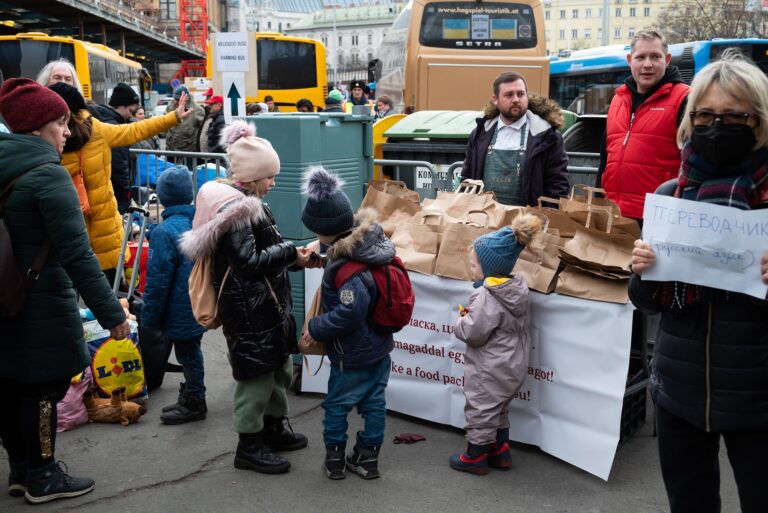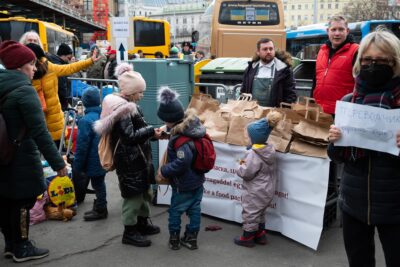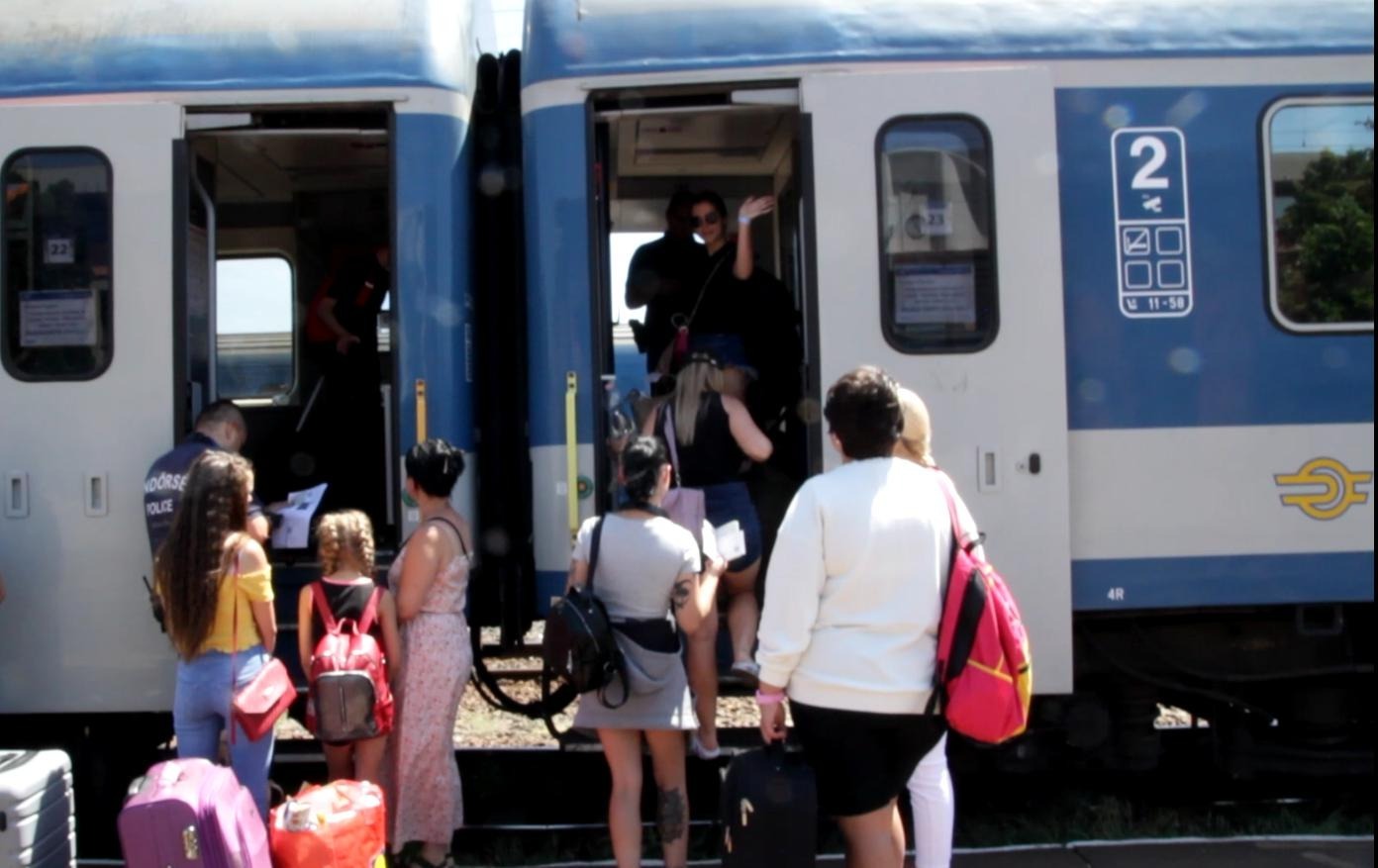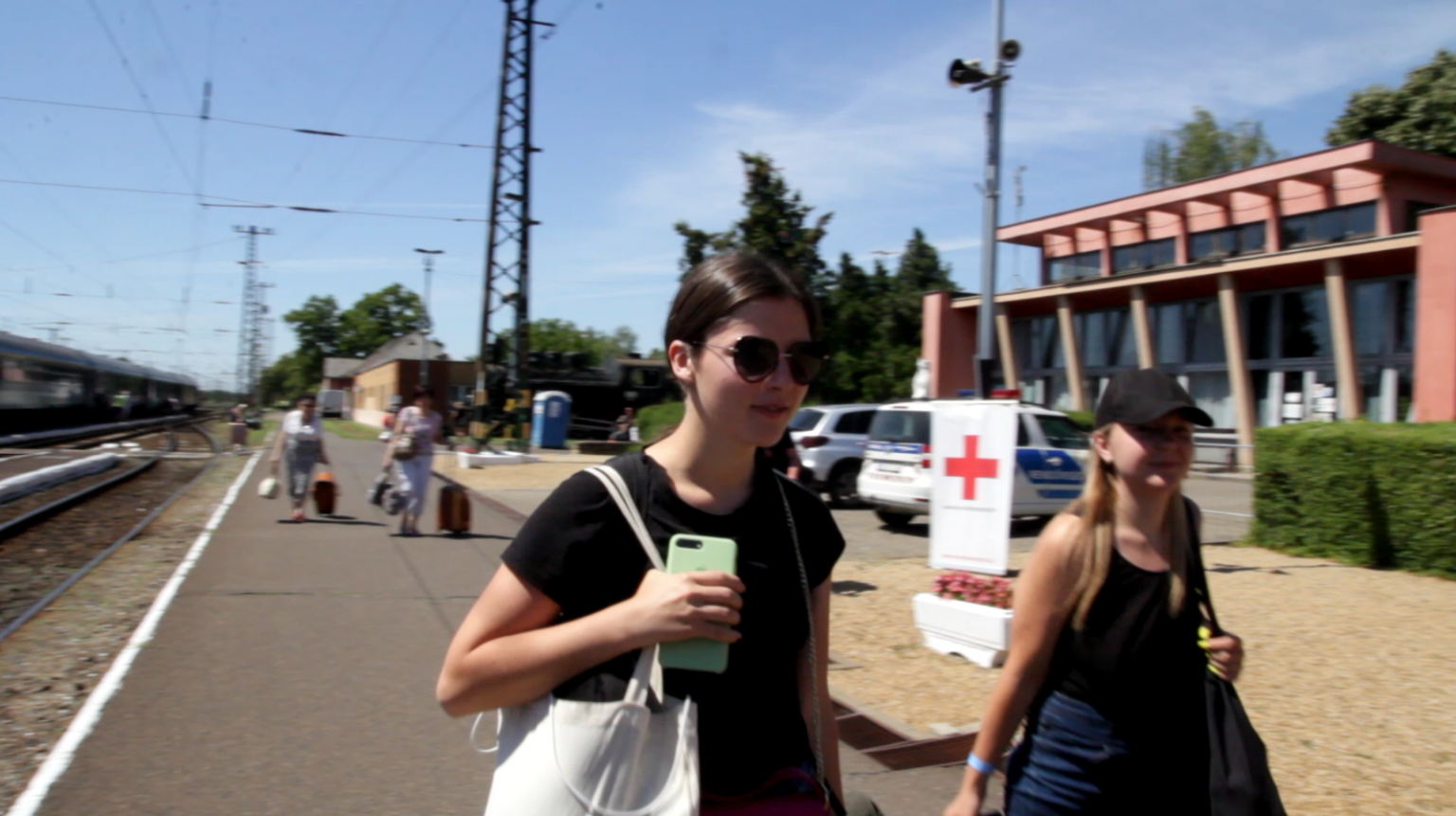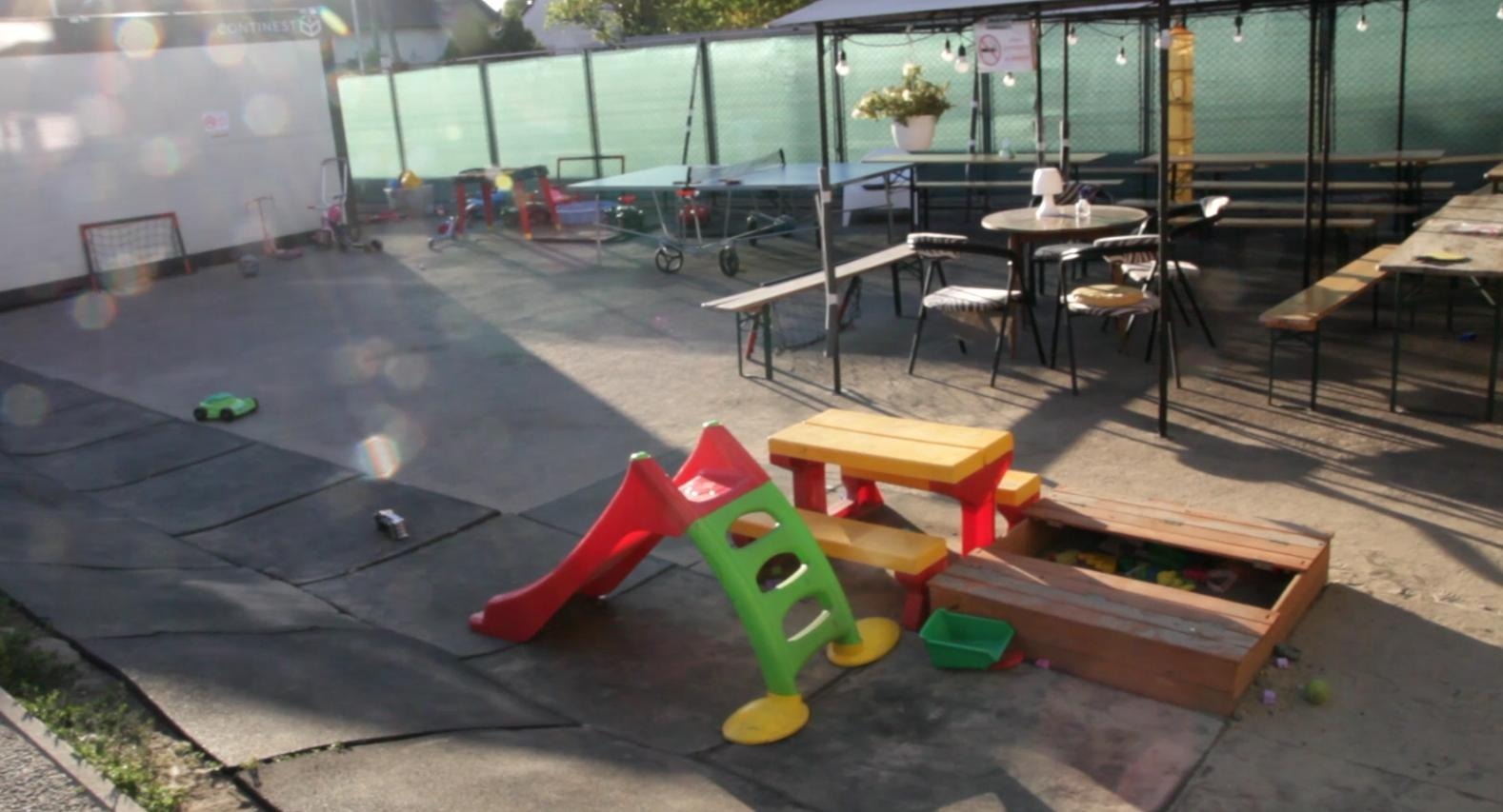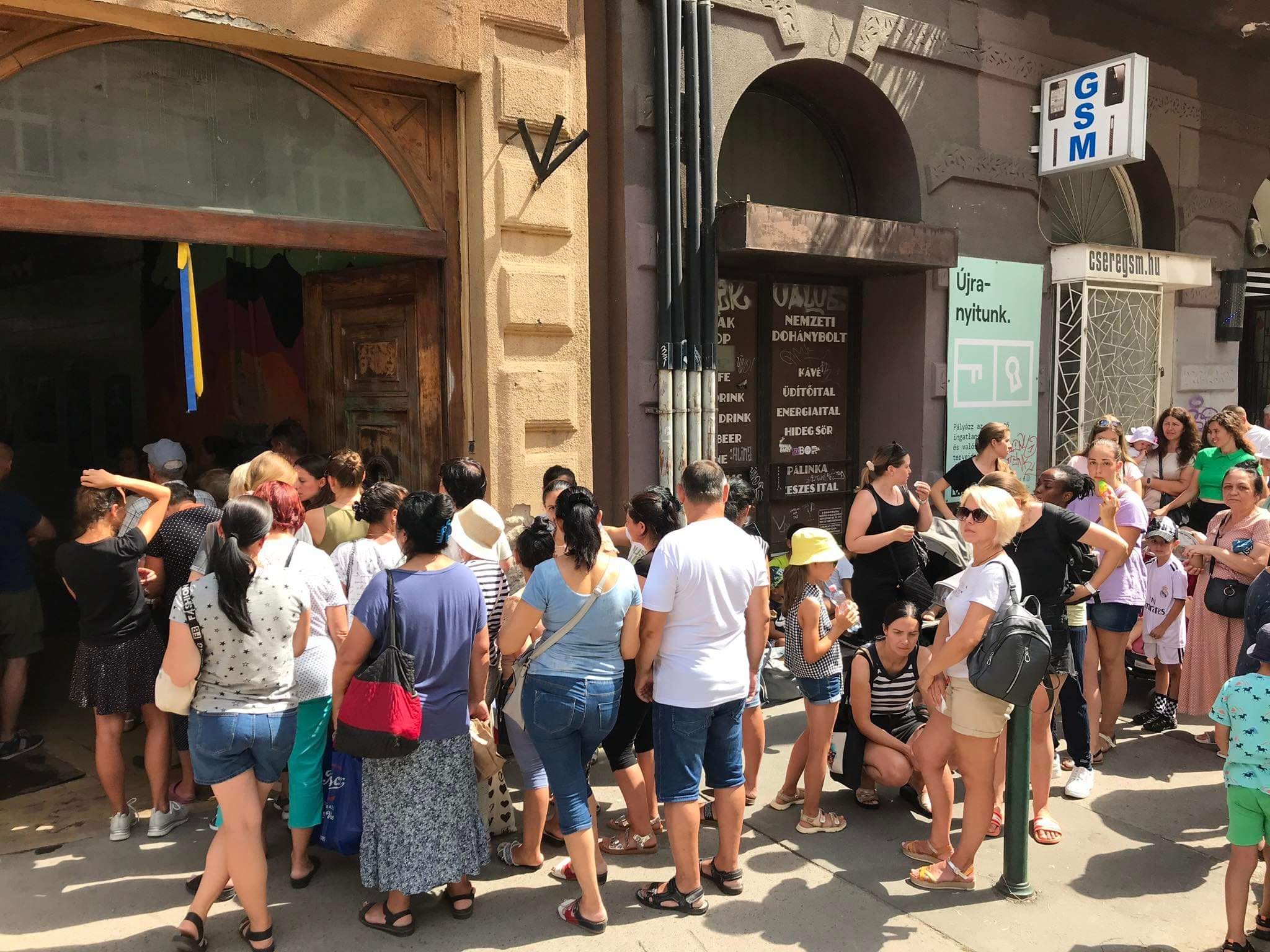Even though there are barely more than twenty thousand refugees from Ukraine in Hungary (as opposed to the government’s claims of hundreds of thousands, or over a million), the refugee care system is still crumbling. NGOs and volunteers are trying to fill the gaps with varying degrees of success. The biggest problem is the lack of flexible, accessible accommodation in the capital, but governmental stinginess and lack of conceptual thinking taints the whole process. Átlátszó followed ended the journey of people from Ukraine from the border to the refugee shelter on Madridi út.
This article was originally published in Hungarian on atlatszo.hu.
The care of refugees from Ukraine in Hungary is carried by volunteers, civilians, aid workers. They are the ones who come into personal contact with the refugees fleeing the war and often follow their fate for weeks or months. Because when refugees find themselves in absurd, unlivable situations in the confusion of state care, they seek out those they really trust – even if they have long since officially had nothing to do with it.
As a Malteser International volunteer told us: one of the families he met at the border in March had been struggling to make a living in Hungary for months, when they were unexpectedly transferred from the dormitory in Gödöllő to a village near the border, where they were accommodated in a church shelter. There are practically no job opportunities in the village, they must sleep on the floor of the common room of the church building and were provided only with milk and bread.
A similar story was told by a Migration Aid staff member who was approached by a former client who was told that he was only fed once a day in the refugee shelter provided by the Disaster Relief Agency. According to him, the refugee shelter itself was a motel next to a motorway. It is not a place where one likes to spend months, especially with family. It is also almost impossible to find a job there.
What is irreplaceable as shelter is poor as a perspective.
The staff of Átlátszó spent several weeks over the summer mapping the Hungarian refugee care system. We traced the journey of asylum seekers from Ukraine from the border to the refugee shelter on Madridi út. We worked as volunteers in shelters, queued at the immigration office and spoke at donation distributions. We compared Hungarian aid with what is being done in other V4 countries.
What emerged was that the Hungarian state refugee assistance provides temporary shelter, but no perspective for those fleeing the war in Ukraine.
What do refugees get?
The Hungarian state will provide free accommodation, food, medical assistance, and financial aid to refugees from Ukraine. This so-called subsistence allowance is 22,800 HUF per month for those who do not have a job. Children receive an additional 13,700 HUF. This is an extremely low amount. Experts say that in Hungary, before this year’s inflationary shock, those who do not need to spend on accommodation needed an income of between 100,000 and 130,000 forints to reach the subsistence level.
Refugees from Ukraine are provided with accommodation by the Hungarian state, but to apply for it you first must travel from the border to the BOK stadium in Budapest. Here, refugees are sorted into two categories: those who plan to stay longer term are dealt with by the Hungarian state, or more specifically by the Disaster Relief Agency (Katasztrófavédelem), which organizes refugee care. They disperse the Ukrainians they receive to refugee camps all over the country.
The other group, planning to travel on from Hungary, will be sent to the hostel of the NGO Migration Aid on Madridi út, where NGOs and volunteers, working without state support, will help the refugees with their handy work. Some, of course, will bypass these two options for free accommodation and try to make their own way either to stay or to continue their journey.
But only those who are registered as so-called ‘asylum seekers’ with the immigration authorities can benefit from any public assistance provided by the refugee support system.
Therefore, the total number of people who have applied for asylum at the Aliens’ Registration Office is the only way to know how many of them are receiving any Hungarian state assistance. This figure of a few tens of thousands is far below what the government is used to claim.
Months of waiting for asylum status
“Originally we were going to Poland, but we were afraid that they would be attacked by the Russians, because the Poles have clearly condemned the aggression. We thought Hungary was safer from that point of view,” a woman with a small child from Kiev told an Átlátszó reporter outside the Harmat utca branch of the Immigration and Nationality Office.
After the beginning of the Russian-Ukrainian war, this Budapest office was designated by the government to handle asylum applications from Ukrainian citizens. There is also a tent in the courtyard of the 10th district office for asylum seekers waiting to be processed, but there was no need for this when we were there. Despite a wave of millions of refugees from Ukraine, there were no large crowds or even a major queue outside the office. People were arriving one by one every 15 minute to register or enquire about the status of their asylum application.
While this might seem to be testament of the efficiency of Hungarian bureaucracy (after all, asylum applications can be submitted online and at other public offices, although all the applications are processed by the Aliens’ Police), the reports of asylum seekers paint a different picture: most of them say that they have been waiting for at least two months for their asylum application to be examined and are currently staying in Hungary with a temporary humanitarian visa.
The woman from Kiev said that the office staff told them to be patient, saying that it could take another two months before they would be granted long-term residence and work status. The waiting period of several months is also problematic because since 29 April, the subsistence allowance is only granted to registered refugees.
One million or twenty thousand refugees?
In Hungarian government communications, there are different figures circulating about how many asylums seekers Hungary has received since the beginning of the war in Ukraine, but they are always claiming hundreds of thousands. Tamás Menczer, State Secretary for Foreign Affairs, recently said in a video lecturing the Estonian ambassador that “Hungary is currently carrying out the largest humanitarian operation in its history in relation to Ukraine, we have already taken in at least a million refugees”.
In an interview with Fox News in July, Szijjártó said that we have already taken in 840,000 asylum seekers who are receiving full care. He also reiterated the much-vaunted claim that Hungary is currently implementing the largest humanitarian operation in its history.
A little earlier, the figure of more than 840,000, quoted in July, had been quoted: when the government was discussing EU funding to help refugees, it had already referred to 1.3 million refugees.
In reality, these figures do not represent the number of refugees accepted or the number of people seeking asylum in our country.
These figures probably simply refer to border crossings, as more than 1.1 million people have crossed the border since the outbreak of the war. But this does not only include asylum seekers, but also people who, for example, are just passing through Hungary, visiting relatives, or commuting across the border.
The number of Ukrainians who applied for asylum in Hungary was 24,615 in June, of which 17,076 were accepted, according to government figures.
More recent figures from the UNHCR (United Nations High Commissioner for Refugees) show that 28,289 asylum applications were made.
So far, more than 3.2 million Ukrainians have registered for temporary protection in all EU countries, most of them in Poland, Germany and the Czech Republic. Hungary is below 1 percent of the EU effort for refugees, based on these figures. Among the EU countries neighbouring Ukraine (Poland, Romania, Slovakia), we have by far the lowest number of asylum applications, while many smaller Western European countries not even neighboring Ukraine, such as Belgium, Ireland, and Portugal, have also received more asylum seekers.
More commuters than refugees at the border
If someone arrives in Hungary from Ukraine and wants to apply for official assistance – such as accommodation, food, help with making an asylum application – they are, in the best case, directed to the coordination and transit centre set up in the BOK stadium in Budapest at the border. The official transit lounge is not at the border, but in Budapest, and you must find a way to get there.
At the Beregsurány border crossing, for example, the procedure would be for border guards to signpost refugees seeking assistance to the Maltese Relief Service help center in the Centre of the village. The Maltese would then call the driver of the municipal bus, who would rush to the border to pick up the refugees and take them to the help point.
At the aid center, they can provide hot meals, toilet facilities and temporary accommodation for refugees from Ukraine on request. But most importantly, the onward bus will take the refugees to the train station in Záhony, where civilians and volunteers will help them buy tickets and provide information on the next steps to take.
In practice, however, this process, which is very smooth in theory, is not accessible to all. While the police usually inform the public that up to tens of thousands of Ukrainian ‘refugees’ cross the border every day, local NGOs – and presumably border guards – believe that most of them are commuters: people coming to shop, visit family or smuggle goods.
Border guards are not informing everyone about the help available to refugees, and refugees may not know who and how to ask for information – especially if they arrive by car.
In Berehovo, we found the UNHCR coordinator, who said that they usually handed out information leaflets instead of the state authorities. Sometimes they also gave information leaflets to border guards to pass on to arrivals.
At the border crossing point in Berehovo, the Átlátszó correspondent spoke to several Ukrainian refugees who said they had not received any information on where to go for assistance and how to apply for asylum. When entering Hungary, border guards only give them a tourist visa in their passports – now standard across the EU.
A journalist from Átlátszó told them about the free accommodation
We heard a similar story from the two well-groomed, cheerful Ukrainian women we met at the Záhony train station early one evening (their names, like those of the other refugees we spoke to, are not published in this article for security reasons). They were passing through Hungary on their way to Cyprus, where one of them had found a job.
The other told us that he first fled to Poland as a resident of Kiev. A few weeks ago, he returned to Ukraine only to visit his mother in Borodjanka. In this town of thirteen thousand inhabitants, Russian invasion forces bombed residential buildings during the Kiev offensive. Her mother was holed up in a cellar for a month and a half, but at least she survived.
They said that the Hungarian border guards only asked the two friends where they were going. They said they were going to Budapest. Then they stamped a stamp on their passports and goodbye. At the border crossing in Záhony they were given hot food and coffee, and volunteers helped them to buy a discounted ticket. But no one told them what kind of help they could get or how long they could stay in the EU.
They were told their ticket to Cyprus was for the next day and had originally planned to book a room in a hostel. They first heard from colleagues that they could stay for free in a temporary hostel run by Migration Aid: they went there instead. However, they had to get to the BOK stadium first.
Information room at the station
Those coming by car often do not even hear about the hall at all, unless they are at the border or get directions from friends; but it is no easier to find the BOK stadium for those coming by train from Ukraine. The hall, located next to the Puskás Arena, is relatively far away from the Western and Eastern railway stations – 4.6 and 1.7 kilometers respectively – so finding helpers is not as easy for refugees as it used to be when volunteers were waiting for them directly at the stations.
At none of the stations was the transit shelter over-promoted. At Nyugati, an information room for refugees has been set up, but only one sign in the whole station, just outside the door of the room.
In any case, two Ukrainian women arriving by train from Záhony easily found the information room and were escorted to the bus turnaround next to the station. From here, the buses of the capital’s public transport system transport the refugees to the BOK sports stadium.
Sorting at the BOK
The transit shelters in the stadium were set up after the closure of the assistance points run for weeks by NGOs at the stations.
But the transit shelters were also open to NGOs, who continue to play a critical role in refugee care, despite often working for free and providing equipment through voluntary donations.
The transit shelter is run by the Budapest Government Office and the Disaster Relief Agency, but the Aliens Police is also present. Refugees can register here for official assistance. They can apply for accommodation and there are facilities for cleaning and resting on site.
When we visited, the hall was almost completely empty. Volunteers tell us that more people gather in the otherwise well-equipped and well-cultivated waiting room in the evening. However, it is obvious that the facility cannot serve more than a few hundred people at a time.
Improvements had to be made to the accommodation
One of the main functions of the waiting room is to direct arriving refugees to accommodation. According to the volunteers working in the hall, the following practice has evolved: arrivals are asked by the disaster management staff how long they plan to stay in Hungary. Those who plan to stay longer, for example if they would like to apply for asylum status, are directed to the refugee shelters.
According to information from Átlátszó, these shelters had to be set up from scratch in February, as Disaster Relief does not have its own properties to accommodate the masses. The authority therefore had to improvise and rented out municipal, church, and private properties (mainly boarding houses and workers’ hostels) in different parts of the country to accommodate asylum seekers. It is understood that Disaster Relief can pay accommodation providers four thousand forints per night.
Disaster Relief does not say where exactly these shelters are, but the quality of the accommodation is mixed, according to reports from refugees. Some have been accommodated in very upmarket guesthouses with private rooms. Others complained of overcrowded, inaccessible public accommodation.
The process itself is quite chaotic. We understand that when a refugee indicates that he or she wants accommodation, the first thing the emergency services colleague tells them is to wait. At this point, even he does not know where he will send them. He calls his supervisor, who tells him where there is space. The bus arrives to pick up the refugees; they will know where they are going at about this time.
The National Directorate General for Disaster Management told Átlátszó in July that they had coordinated the resettlement of 11 945 people since the outbreak of the war.
14 counties (Bács-Kiskun, Békés, Borsod-Abaúj-Zemplén, Fejér, Győr-Moson-Sopron, Hajdú-Bihar, Heves, Jász-Nagykun-Szolnok, Komárom-Esztergom, Nógrád, Pest, Somogy, Szabolcs-Szatmár-Bereg, Tolna) are involved is the accommodation of refugees fleeing the war. As far as we know, Disaster Relief are not accommodating any refugees in the capital.
Those refugees who do not plan to stay here long-term are directed by government staff in the BOK stadium to a volunteer organization called Migration Aid.
Temporary accommodation in Budapest only from NGO donations
The name of Migration Aid became well-known after Fidesz-allies launched a relentless smear campaign against them. Four years ago, Fidesz-affiliated circles even hired an Israeli private intelligence firm to produce dirt on this NGO.
In the current crisis, they have been involved as civilian refugee aid workers from the very beginning, but their work is especially important because in Budapest, more precisely on Madridi út, they have a hostel where they can accommodate 217 asylum seekers at a time in dormitory rooms. Today, if a refugee wants to find accommodation in Budapest, they have few choices, safe from renting an apartment. Short-term accommodation is almost impossible to find in the whole country.
In the third week of the war, Migration Aid opened a temporary shelter on Madridi út after a volunteer offer, and later a similar shelter in Győr. Originally intended as a transit shelter, it was later made available to allow people who were just passing through Hungary but had to wait for relatives or did not know where they could go to stay longer.
Those who are directed by government office staff to the Migration Aid stall are now taken from the BOK to the Madridi út by volunteer drivers. One of the drivers told us that the guided tour has also become part of the journey. From the window he shows the refugees the illuminated Heroes’ Square, the Museum of Fine Arts and Andrassy Avenue.
Everyday life on the Madridi út
Our journalist volunteered for days on the Madridi út. Her description on everyday life:
Migration Aid is only out between 4pm and 2am at the BOK-Csarnok, where refugee registration takes place, so the Madridi út hostel is at its busiest at night. This is when the new refugees arrive: children run around in the courtyard, and refugees wait at the reception desk among suitcases, prams and bags to be registered and shown to their rooms. In the kitchen, volunteers prepare sandwiches, often with the help of a refugee or two who used to live here. The hostel is much quieter in the morning. The volunteers are exhausted from the night shift. They are waiting for a change. The day team has the task of unloading the refugees who are leaving that day. If they need a lift, they will provide them. The refugees are taken by taxi or minibus to the train station or airport. They also must be prepared for the evening rush hour: the volunteers prepare clean bedsheets – there are hardly two identical sheets on in the hostel, since everything is donated – clean the rooms and, if necessary, fix the broken toilet tank. Volunteers must make sure that there is always fruit and vegetables for breakfast (which, given the night-time arrivals, often lasts until midday) and make sure that there is always someone in the storeroom to give out toiletries, diapers, medicine, or other essentials for daily living to the refugees. Everything is donated. At noon, you must take the food from the fridge and pick up tomorrow’s rations, which are offered to the refugees by one of the kitchens.
“In the first few weeks, the state agencies were hardly involved in the relief work, which was outsourced to the Charity Council, but the supply was largely carried by civilian volunteers. Even now, short-term accommodation is not fully covered, and we are trying to fill the gap. We have developed a practice, a cooperation between us and the authorities, whereby those who need accommodation are referred to us,” András Siewert, the organization’s founder, told us.
But Migration Aid still operates without any government support. It is still 100 percent funded by volunteers.
In the early 1990s, during the Yugoslav wars, an unprecedented number of refugees arrived in Hungary. At the time, the state took in 100,000 people – in fact, this was the largest humanitarian operation in the history of modern Hungary. At that time, a relatively well-functioning refugee system was established, and several large refugee camps were built, such as the centers in Bicske and Vámosszabadi. However, after the 2015 refugee wave, this structure has steadily deteriorated.
“Anti-refugee sentiment has become a political issue, and following the rhetoric, people have started to eviscerate the refugee issue and deliberately create a hostile environment for asylum seekers,” said András Siewert, adding that while the state is now accepting Ukrainians, the former, often illegal, procedures are still being applied at the southern border.
“After 2015-16, several staff members of the Immigration and Nationality Office were made redundant, and since then the organization has been critically understaffed, which has caused problems during the current wave, for example, a general lack of interpreters,” said Siewert, “That is why the tasks were taken over by the Charity Council and government agencies instead of the Aliens Department.” The Migration Aid founder, on the other hand, said it was incomprehensible why the remaining refugee camps in Bicske and Vámosszabadi had not been reopened, when there was clearly not enough accommodation capacity for asylum seekers, even though very few would stay in Hungary.
A new wave could come in the autumn
Although at present the small number of asylum seekers remaining in Hungary are largely receiving some form of care and accommodation, their future is uncertain. András Siewert said that most of the refugees are currently staying in rented tourist accommodation, but that this could disappear in the autumn, when the heating season starts, as it will no longer be economical for the operators to accommodate them.
The state cannot even provide education in Ukrainian Tamás Menczer, the Hungarian state secretary for foreign affairs, when arguing with the Estonians about how much the Hungarian state helps Ukrainians, also boasted that Hungary helps to send refugee children to school. However, Zoltán Maruzsa, the state secretary for education, also admitted that Ukrainian-language education could not be provided on a large scale because there were no schools with qualified teachers. Volunteers are therefore also playing an important role in education, including the NGO initiative to set up a school for school and kindergarten children from Ukraine at the Peace School in Zugliget. Migration Aid also organizes day care, András Siewert told Átlátszó that they have recently recruited 16 Ukrainian teachers and social workers who will organize activities for the children who stay here. “This is the first time that we have paid staff working on a project instead of volunteers,” he said.
“The situation could be made worse by the possibility of another wave of refugees in the autumn. Ukrainian IDPs are now largely in forced camps in western Ukraine. If the war drags on and the IDPs see that they cannot go home for much longer, masses of them could start heading west again. All aid agencies are expecting this, but I don not see the government preparing for such a situation,” said Siewert.
Where there is work, there is no accommodation
Siewert says it is not clear at the moment what the government’s concept is with asylum seekers. “What is certain is that companies see a great opportunity in their work, and the government has also issued a decree that has made it easier for Ukrainian citizens to work in Hungary. So, the intention seems to be to keep many of them here as workers, not to keep them out, as with the refugees from the Middle East, or to push them quickly to the West.
But the workers also need accommodation, but now the state can only provide accommodation mainly in small villages, where there is no work. There are jobs in Budapest and the cities, but there is no accommodation there.”
The state refugee scheme would have a bridging solution to this situation: support for employers who also provide accommodation. Employers who hire and accommodate Ukrainian citizens would be reimbursed by the state up to half of the accommodation costs of the person concerned, up to a maximum of HUF 60,000 per month (plus HUF 12,000 per child).
It is not known how successful this form of support will be, but given the total number of asylum applications, it cannot be too much of a success. The fact that a Fidesz-affiliated recruitment agency, Prohumán Kft., has been granted a full monopoly on the presence of the company in the BOK stadium, which is a strategic partner of the government and is owned by Tamás Deutsch, has been the sole recruitment agency in the BOK stadium since the start of the transit shelter, offering accommodation for work to several asylum seekers.
At the same time, the NGO helpers we interviewed reported that they are regularly contacted by companies asking if they can offer them workers. We are not aware of any thorough monitoring of this secondary market.
The obvious flaws in the scheme leave refugees vulnerable to employers in more ways than one. And this obviously discourages refugees who seek any kind of personal autonomy and have a choice. Most of them have so many choices, whether to stop in Hungary or to go one or two borders further elsewhere in Europe.
How do they do it elsewhere?
In Slovakia, a total of 76,000 people had applied for temporary refugee status by the beginning of July. At the end of July, a total of 8,000 refugees were employed in Slovakia and 44,000 were receiving financial assistance. This was initially provided by the Slovak government and since May by international organizations such as UNHCR, UNICEF, IOM and IFRC, with a monthly amount of €32,000 for adults, €65,000 for children under 3 years old, €24,000 for children aged 3-18 years old and a maximum of €154,000 per family. Until May 2022, the Slovak state has spent a total of €2 791 497,10 on financial support for refugees from Ukraine.
Ukrainian refugees in Slovakia with temporary refugee status are also entitled to a financial contribution to housing. This amount is not paid directly to them, but to the person or company providing them with accommodation. The scheme has so far cost a total of 13,5 mln euros.
An area of continuing concern is the financing of the integration of Ukrainian refugees: the provision of Slovak language and culture courses, etc., which is now largely financed by municipalities. The Slovak government plans to use the nearly half a billion euros of EU funding left over from the 2014-2020 period for projects related to the refugee crisis, plans are still being worked out.
Poland currently hosts the largest number of Ukrainian refugees. According to Polish border police data from 25 July, a total of 24.5 million people crossed the Polish-Ukrainian border since February. It is difficult to estimate exactly how many remain, but according to unofficial estimates by the Centre of Analytics and Research, there were 3.4 million Ukrainian refugees in Poland in May.
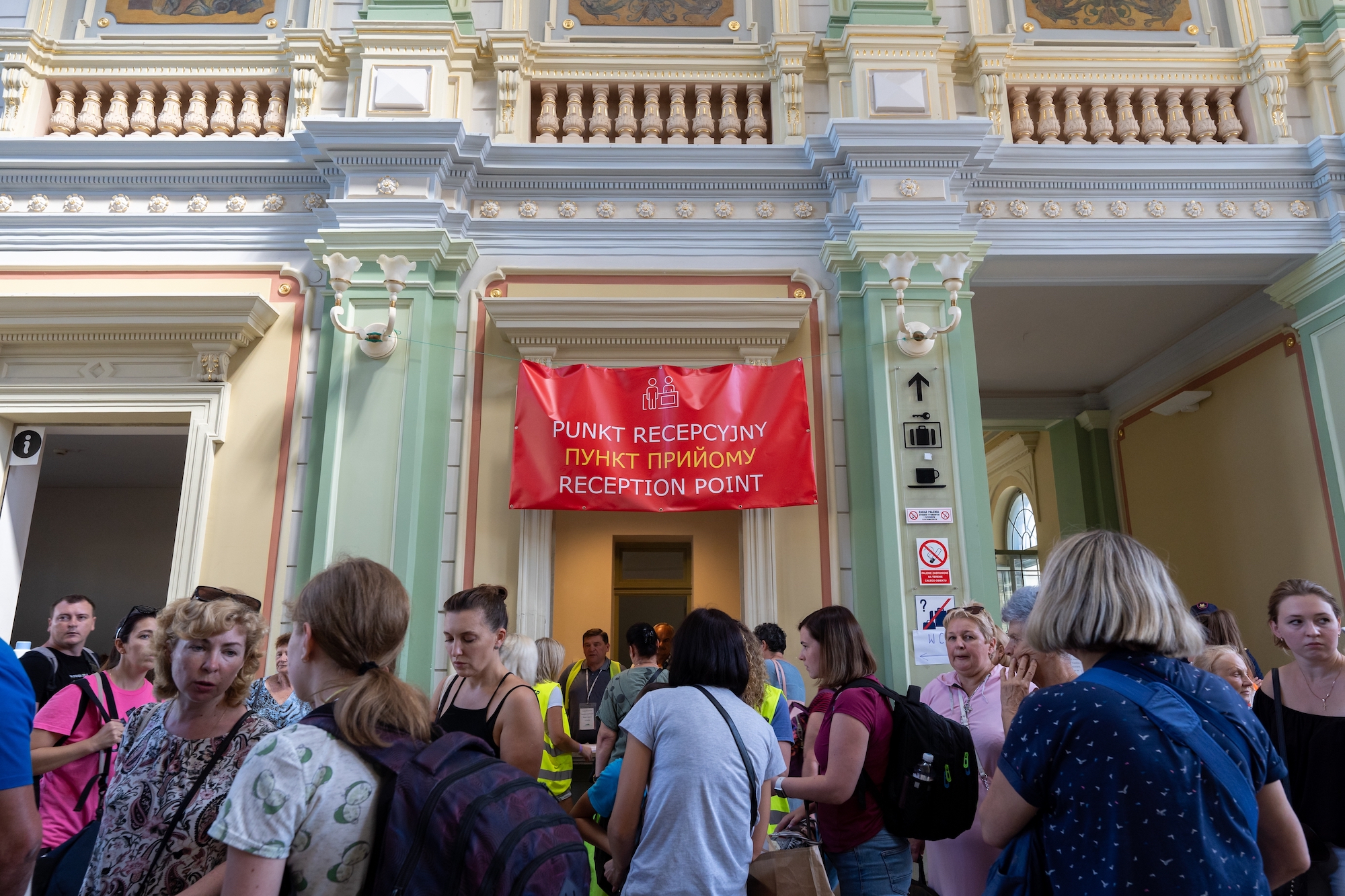
Reception point for refugees from Ukraine at the railway station. Przemysl, Poland, 16 July 2022. Source: Daniel Sztork / Shutterstock
All Ukrainians who arrive in Poland fleeing the war have 15 days to apply for refugee status. However, this is not mandatory, as refugees from Ukraine are automatically granted temporary protection status. It is highly recommended to obtain a Polish identification code, PESEL, immediately upon arrival. This entitles you to free medical care, employment, and other benefits. According to analysts at the Polish Economic Institute, 1 million 225,000 of these PESEL numbers have been issued to refugees from Ukraine so far.
Upon arrival, adults were entitled to 300 zloty (USD 65) and children to a one-off allowance of 500 zlotys. In addition to this one-off allowance, the Polish government provides money worth 40 zlotys per day for 120 days to those who take in refugees from Ukraine in their own property.
According to a summer analysis by the Polish Economic Institute, the Polish government plans to spend a total of 1 359 billion zlotys (USD 3,61 bln) by the end of the year to help refugees from Ukraine. Currently, the total value of aid provided to refugees by the authorities and Polish citizens amounts to almost 1% of Polish GDP.
In addition, UNHCR launched a cash assistance programme in April in two offices in Warsaw and Krakow. Refugees eligible for assistance can claim 700 zlotys per month for the first three months (with an additional 600 zlotys per household member, but not exceeding 2,500 zlotys per household per month).
The State Health Fund offers some basic health care free of charge, but you will have to pay for more complex care.
In the Czech Republic, a total of 400,000 Ukrainian refugees had been granted temporary protection visas by the end of July. It has the highest number of refugees per capita of any European country. Most of them are women and children. One third of them have a degree.
More than 95,000 refugees have found work in the Czech Republic, almost 80% of them in jobs that do not require any special qualifications or training.
Ukrainian refugees can apply for humanitarian aid in the Czech Republic. They can receive six grants of 82,000 Czech crowns. The amount is reduced slightly from the seventh occasion onwards. Over forty percent of the refugees lived in Czech households that provided them with accommodation. By the end of June, the cost of the war in Ukraine and the refugee crisis amounted to 168 billion Czech crowns.
As of 19 July, health insurance for refugees is no longer covered by the Czech state. Ukrainians will now have to register with an insurance company and pay for the insurance themselves – unless they are employees, in which case the employer will cover the cost.
Here is where the Hungarian state is making a mess of things
A comparison with the other Visegrad countries reveals the following lessons: firstly, the level of assistance provided by the Hungarian state is far below that of the other V4 countries.
This is true both individually and in absolute terms, since even Slovakia, with a population of 5.4 million, is hosting more than three times as many refugees as Hungary, not to mention the Czechs and Poles.
The only item in which Hungarian aid exceeds that of others on paper is the provision of full free health care for asylum seekers. But knowing the state of the dilapidated Hungarian health system, the real value of this in practice is questionable, to say the least.
In all three countries, the value of the cash assistance available for subsistence is significantly higher than the approximately HUF 23,000 per month an adult in Hungary receives (the default value is HUF 60,000 in Poland, HUF 82,000 in Czechia, and HUF 32,000 in Slovakia).
Another issue is that the Hungarian benefit system does not involve the competent large international organizations, whereas today in Poland and Slovakia such institutions also provides cash aid. We certainly do not know the reason for this, but it can be assumed that the Orbán government, which has turned its ‘anti-migrant’ rhetoric into ideology, does not ask for help from these organizations for political reasons.
The UNHCR, which is also providing financial aid in Poland and Slovakia, has been regularly attacked in recent years by the media close to Fidesz, saying that they are resettling migrants in Europe, handing out migrant cards and giving billions to migrants.
The International Organization for Migration (IOM), which is helping Slovakia, has been accused of being a ‘pro-immigration organization funded by George Soros’, and even argued in a separate letter with Foreign Minister Péter Szijjártó that refugees should be sent home, not helped.
In terms of political communication, it would be an impossible task for the Orbán government to accept the help of these organizations. There are, however, two areas where it would not be politically costly for the Hungarian government to learn from the V4.
For example, the government, which claims to be family-friendly anyway, might realise that it is worth giving more support for a small child than for an adult.
This aspect can be observed in the Polish and Slovakian support systems, with a marked differentiation in the Slovakian system, where an adult can receive 32,000 HUF per month, while a child under 3 years of age receives double that amount. This logic is both a simple humanitarian one and a reflection of the problem that it is more difficult to work with a newborn.
The other correctable shortcoming is that the government today does not help ordinary Hungarian citizens who would take in a Ukrainian refugee into their home.
In a situation of housing and accommodation shortages, state support for individual solidarity would be the easiest way to make housing in the capital accessible to more refugees. This is how it is done in Slovakia and Poland.
Although Hungary has a higher housing allowance (HUF 4,000 and 3,400 per night) per refugee than, for example, Poland, this is only available to accommodation providers who house at least 20 refugees and have an agreement with a branch of the state to this effect.
This is clearly not available to the average Hungarian citizen who takes one or two refugees into their average-sized flat. In particular, the subsidy is not available to those who have otherwise offered their accommodation voluntarily.
The cost of help
How much does it cost the Hungarian state to help refugees from Ukraine? The exact figure is not known. Átlátszó estimates that today financial aid costs up to HUF 400 million per month, while housing assistance costs up to one and a half times that amount. Added to this are additional costs such as the construction and operation of the BOK stadium, and reduced transport fares. The total cost of normal operations is expected to be under one billion forints per month.
The Charity Council, which is active in the border assistance points and present in the BOK stadium is an umbrella organization of several church-based aid organizations. At the start of the crisis, they received a one-off grant of HUF 3 billion.
Before this article was published, we asked the secretary of the Charity Council what the state funding was spent on, how much of it was spent on feeding and housing asylum seekers, or even on paying their staff. We also asked how many people the council’s member organizations could now accommodate and whether they were taking steps to house those who had no place to stay. In response, the council’s secretary offered the central press email address of the Prime Minister’s Office, saying we could get answers to our questions there. At the time of writing, we have not yet received a reply from the Prime Minister’s Office. All we know for sure is that a small number of temporary accommodations is run by the Catholic Charity, which this summer camped 3,600 children (this was not a particularly expensive program, according to them, costing 60 million forints). In Beregsurány, the Malteser International runs a container camp where they can accommodate those who request it for 2-3 days. When we were there, the camp was not very crowded, with up to 5 families spending the night.
There is also a program to enable 1,000 Ukrainian university students to continue their studies in Hungary, and a higher education program specifically targeted at people from Transcarpathia – these cost a total of EUR 3.38 billion.
The total Hungarian budget for Ukrainian refugees this year likely does not exceed HUF 15 billion. This spending is dwarfed by the hundreds of billions of Czech or thousands of billions of Polish aid.
The government spent EU money elsewhere already
In April, the European Union gave Hungary €263.2 million – roughly HUF 102.5 billion – from the REACT-EU fund. REACT-EU is part of the NextGenerationEU post-COVID recovery package, which the EU has been withholding from the Hungarian government for nearly a year over corruption risks and rule of law concerns. At the start of the refugee crisis, the EU allowed refugee-receiving countries to receive funds earlier than planned so that they could use the money to help refugees in Ukraine, which is how the Hungarian government received billions of forints.
But the Hungarian government spent this money on other expenses. In June, the Prime Minister’s Office told hvg.hu that, as the money was originally intended for the resumption of the Hungarian refugee crisis, the government had already spent it for purposes unrelated to the refugee crisis.
“In April, we received an advance under REACT-EU from EU funds that Hungary was already entitled to and had already been committed for other purposes. Unfortunately, this does not represent a single euro of new EU funding for the country,” they said. According to hvg.hu, several public procurement contracts have been paid from this fund, and plaques referring to REACT-EU can be seen at the entrances of restaurants reopening after pandemic closures, for example.
Hungarian refugee from Transcarpathia thrown out of accommodation
At the end of July, we attended a fundraising event at the MANYI House cultural center in Buda. The Hungarian Two-Tailed Dog Party (MKKP), which won 3.27% of the vote in the last elections, is the only organised political party outside parliament actively involved in helping refugees, and they also run a small refugee shelter where they can accommodate dozens of asylum seekers.
When we visited, the building’s courtyard was completely full of asylum seekers waiting for food parcels, mostly families with young children. The arrivals were given food parcels on presentation of their asylum status or temporary humanitarian card, the result of two weeks of fundraising. The majority of those we spoke to had applied for asylum status in Hungary, but so far, they have only received a temporary humanitarian residence card and are still waiting for proof of protection status.
Here we met a Hungarian woman from Transcarpathia, who does not have dual citizenship, who crossed the border with her husband and four children. As she said, they had been sent from the BOK stadium to a workers’ hostel in Tatabánya by the Disaster Management.
But after a month or so, they had to leave the accommodation because the new arrivals needed space.
“It’s not that we were in the same room with the four children, but it’s in a place where there’s no shops or playgrounds nearby,” he said of the accommodation in Tatabánya, from where the family had come to Budapest that day in the hope of finding a sublet.
But it is not easy. “When they hear that we are from Ukraine or that we have four children, it doesn’t matter which one we say first, they say hello, but no,” said the Hungarian woman who fled from Transcarpathia.
Contributors: Anastasiia Morozova (Frontstory.pl), Dankulinec Nikolett, Hava Nikita, Mahulena Kopecká (Investigace.cz), Tomáš Madleňák (ICJK). The cover photo shows the entrance of the Madridi út accommodation, taken by Boglárka Rédl. The press archive for this article was provided by the Arcanum database.
 Support independent investigative journalism in Hungary,
Support independent investigative journalism in Hungary,
become a patron of Atlatszo on Patreon!
You can also donate here.
Zalán Zubor began working at Atlatszo.hu in 2022. Zubor covers topics related to Russian influence in Hungary and corresponding security risks, as well as the Hungarian government’s stance on the war in Ukraine and refugees in Hungary.

